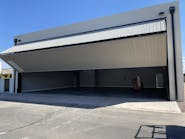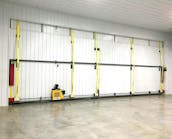Moving an Aircraft Hangar: 4 Steps to Complete the Creative Solution
Airports are expected to manage complex logistical, regulatory, safety and consumer-related requirements — all while remaining as efficient as possible. When infrastructure challenges arise, regardless of scale, airports require a strategic engineering approach to implement effective solutions. An exemplary project is the relocation of an aircraft hangar, which may not seem possible due to its size, but if approached systematically, can be relocated successfully.
This article addresses four tactical engineering steps to plan and execute an effective aircraft hangar relocation project. Following these guidelines can lead to significantly lower costs than building a new aircraft hangar, while supporting sustainability initiatives by reusing the existing materials.
1) Build the Foundation for Project Success
With any airport project early planning and communication are critical to the overall success. For relocation of an aircraft hangar a diverse team of engineers, architects, and contractors are important partners who can provide engineering and feasibility studies which lay the groundwork for the project. This proactive approach often contributes to the project running smoothly while remaining effective and on-schedule throughout.
Best practices involve conducting a feasibility study to analyze the condition of the hangar, identify any required building code upgrades, and establish a construction cost estimate for the relocation of the hangar as well as the cost to build an equivalent hangar with all new materials.
To illustrate, an airport weighing this decision may decide to downgrade the use of a hangar from an aircraft maintenance hangar to an aircraft storage hangar. Doing so could lead to substantial economic benefits as a newly built facility would likely require expensive and unavoidable updates to meet current building and fire codes for a maintenance hangar.
2) Prepare the Hangar for Relocation
In preparation for moving the hangar, it may be required to have a contractor perform selective demolition to remove any components that are unable to be repurposed. For this project, the hangar had lean-to space on each side of the main hangar bay which contained offices, storage, and shop functions. These spaces were not needed on relocated hangar and were demolished prior to moving the hangar.
As-built drawings are often unavailable for older aircraft hangars. It is recommended to scan the foundation and structural columns to locate the anchor bolt patterns and determine the structural member sizes. This information is useful in the design process to calculate the footing and foundation size, as well as during construction to assure that the hangar is placed correctly on the new foundation. The new foundation will need to be in place prior to beginning the process of moving the hangar.
3) Schedule the Aircraft Hangar for Relocation
One advantage of moving hangars on airports is there are typically not any overhead power lines, and the expansive apron and taxiway pavements provide for a clear route to transport the hangar. Even with these advantages, it is still necessary to complete extensive planning and coordination with airport operations staff to ensure project success. Structural moving companies typically require at least two weeks to raise a structure this size and place hydraulic minitrucks underneath. The transportation path from the original aircraft hangar location to the new site may require the use of an active taxiway and/or crossing a runway. In this case, it is necessary to assess the pavement to ensure it can withstand the weight of the aircraft hangar load and to plan for temporary removal of airfield lights and signage.
To minimize the impact on airport operations and reduce downtime, the aircraft hangar relocation is recommended to be scheduled in the evening, allowing runway crossings to occur after the airport’s last daily flight.
4) Reap the Aircraft Hangar Cost Savings and Environmental Benefits
Despite the robust planning and execution of this type of project, significant cost savings can be realized by relocating a hangar compared to rebuilding a new structure. Not only can a hangar relocation result in direct cost savings but reusing the existing aircraft hangar can often enable a quicker time to generating lease revenue.
Moving an aircraft hangar provides additional environmental benefits, because many parts and resources will be reused rather than disposed of or recycled. The airport can also repurpose the existing space—and use less material in the process—to create additional sources of income for years to come.
It’s a significant undertaking, but an aircraft hangar relocation can be accomplished efficiently and successfully. Working with a partner who excels in design, engineering, and construction will benefit your airport. No matter the nature of your aviation engineering project, even the toughest challenges can be solved by an experienced team working from a proven playbook.
Adam Wilhelm, PE is a client director at Foth Infrastructure & Environment. He is a civil engineer by training and an aviation professional by experience. During his 25-year career, he has had the pleasure of completing many complex airport design and construction projects.




